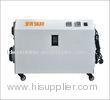|
Hangzhou rui ya electrical appliance co.,ltd
|
energy efficient dehumidifier commercial basement dehumidifier
| Place of Origin: | Zhejiang, China (Mainland) |
|
|
|
| Add to My Favorites | |
| HiSupplier Escrow |
Product Detail
Dehumidifying Capacity: <span style="font-family: arial,
- Dehumidifying Capacity: 19kg/h
- Name: Desiccant Rotor Dehumidifier, Adsorption Desiccant Dehumidifier
- Process air flow: 3000m3/h
- Reactivation air flow: 1100m3/h
- Voltage: 380V
- Current: 60A
- Power rating: 27KW Max power: 30KW
- Applied Temperature: -20°C-70°C
- Body: Stainless Steel
- Dimension: 1295*880*1300mm
- Applications: Used for drying basement, garage, cellar, crawl space, small space
3000L/H Large Commercial Industrial Desiccant Dehumidifier For Basement
RY-3000M series dehumidifiers conform to both harmonised European Standards and to CE marking specifications.
The RY-3000M desiccant dehumidifier is designed to efficiently dehumidify in low moisture applications. The electrical control system conforms to EN 60204 (IEC204) standards.
The electrical components are mounted on busbars and are constructed of halogen-free plastic. The electrical system is designed for up to 400V and 70º C.
Besides, RY-M rotor technology is the precision seals which divide the air distribution chamber. These provide a precise airflow balance for dehumidification and reactivation while allowing for alternative fan placement and rotor sectioning.
How Desiccant Dehumidification Works:
The desiccant rotor is manufactured from a corrugated composite material that is highly effective at attracting and holding water vapour. Every YAKE dehumidifier applies a unique rotor technology. Airflows, air conditions, rotor sections, and rotor rotation speeds are optimised for specific applications. An innovative control system maximises the units energy efficiency.
Desiccant dehumidifiers perform exceptionally well when used in cooler climates, or when a low dewpoint, deep drying or low humidity levels are required because they dehumidify through adsorption. Since desiccant dehumidifiers do not produce water, they will work effectively down to sub zero temperatures. Their operation is simplistic yet extremely effective and reliable.
In a typical dry desiccant system, the desiccant is mounted on a rotating wheel. As the wheel turns, the desiccant passes alternately through the incoming process air where the moisture is adsorbed and through a “regenerating” zone where the desiccant is dried and the moisture expelled. The wheel continues to rotate and the adsorbent process is repeated.
Typically, about three-fourths of the desiccant wheel is exposed to the incoming air throughout the process. During regeneration, the desiccant is heated by a direct-fired gas burner or indirect-fired water or steam coil.

Process Inlet—Air to be dried. May be outside air, inside air or, more commonly, a mixture of air with high humidity content.
Process Outlet—Air is dried by desiccant wheel. May be cooled, filtered or otherwise handled. Relative humidity is substantially lower and temperature slightly raised.
Reactivation Inlet—Air flow, usually outside air, that drives moisture off wheel. Reactivation air is heated by direct-fired gas burner or indirect-fired water or steam coils.
Reactivation Outlet—Hot, wet air from wheel is exhausted outside or passed through an air-to-air heat exchanger. Using a heat exchanger to preheat incoming process air offers substantial savings in northern climates.
Applications:
Places full of corrosive gas
HVAC system
Humidity of less than 35%RH
Low dew point conditions
Low temperatures, especially combined with low humidity
Single pass air flow applications
Pharmaceutical production, packaging, storage, testing and research
Process air systems
Photographic/film archive stores
Pneumatic conveying of powders
Pumping stations
Confectionary production and packing
Food production
Clean rooms
Electronics manufacture
Cold stores
Seed storage
Drying & corrosion prevention inside power station turbines
Injection moulding machines
Tank drying
Specifications:
|
Model |
RY-3000M |
|
Dehumidifying capacity(20°C,60%) |
19kg/h |
|
Process air flow |
3000m3/h |
|
Reactivation air flow |
1100m3/h |
|
|





